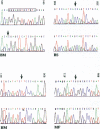Abstract
Barth syndrome (BTHS) is an X-linked disorder characterized clinically by the associated features of cardiac and skeletal myopathy, short stature, and neutropenia. The clinical manifestations of the disease are, in general, quite variable, but cardiac failure as a consequence of cardiac dilatation and hypertrophy is a constant finding and is the most common cause of death in the first months of life. X-linked cardiomyopathies with clinical manifestations similar to BTHS have been reported, and it has been proposed that they may be allelic. We have recently identified the gene responsible for BTHS, in one of the Xq28 genes, G4.5. In this paper we report the sequence analysis of 11 additional familial cases: 8 were diagnosed as possibly affected with BTHS, and 3 were affected with X-linked dilated cardiomyopathies. Mutations in the G4.5 gene were found in nine of the patients analyzed. The molecular studies have linked together what were formerly considered different conditions and have shown that the G4.5 gene is responsible for BTHS (OMIM 302060), X-linked endocardial fibroelastosis (OMIM 305300), and severe X-linked cardiomyopathy (OMIM 300069). Our results also suggest that very severe phenotypes may be associated with null mutations in the gene, whereas mutations in alternative portions or missense mutations may give a "less severe" phenotype.
Full text
PDF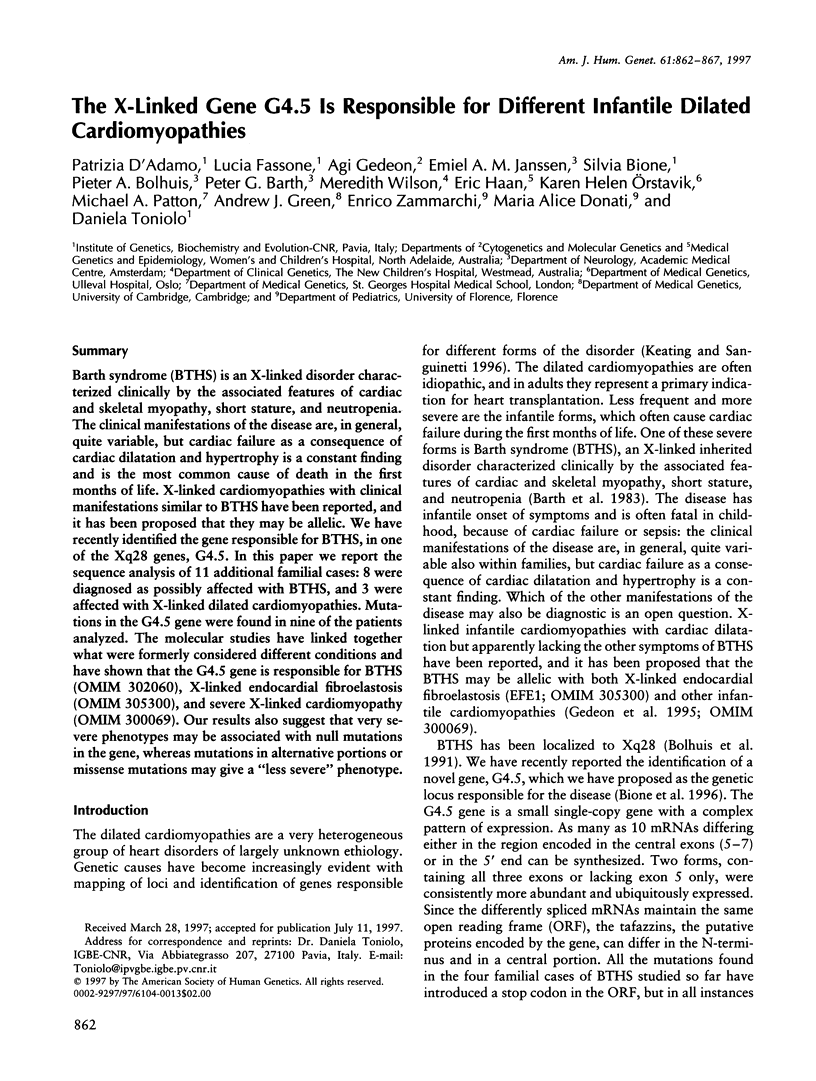
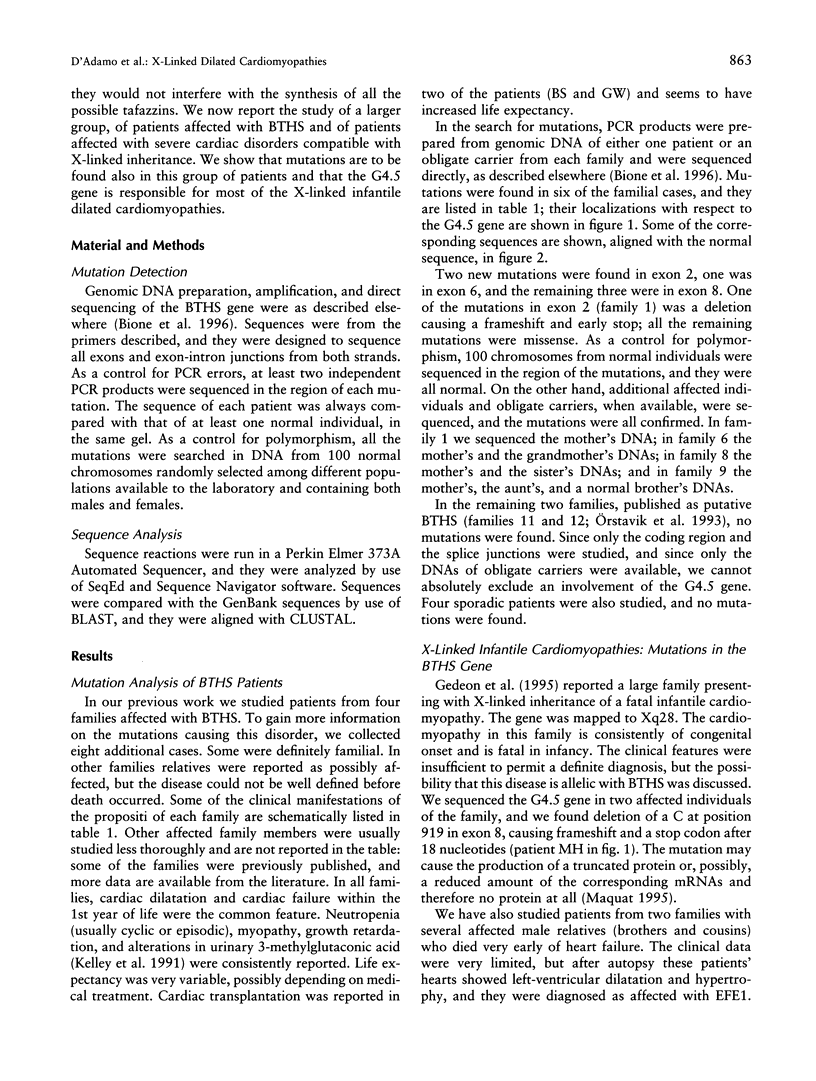
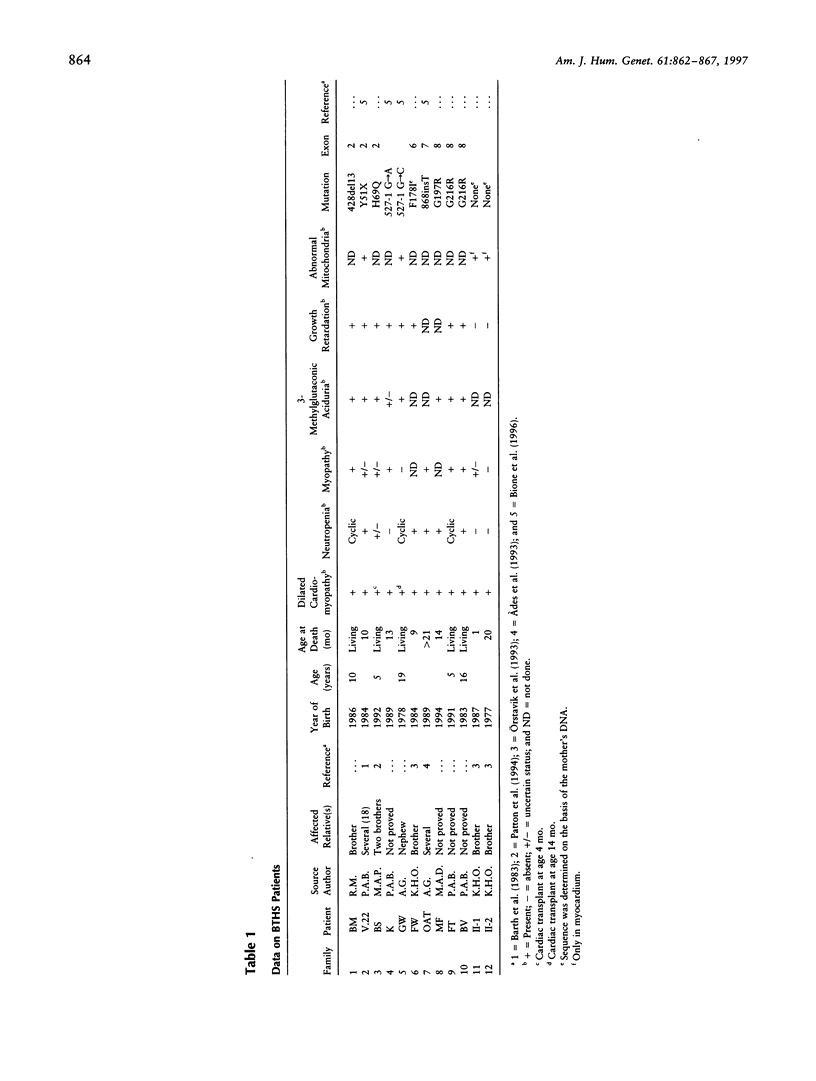
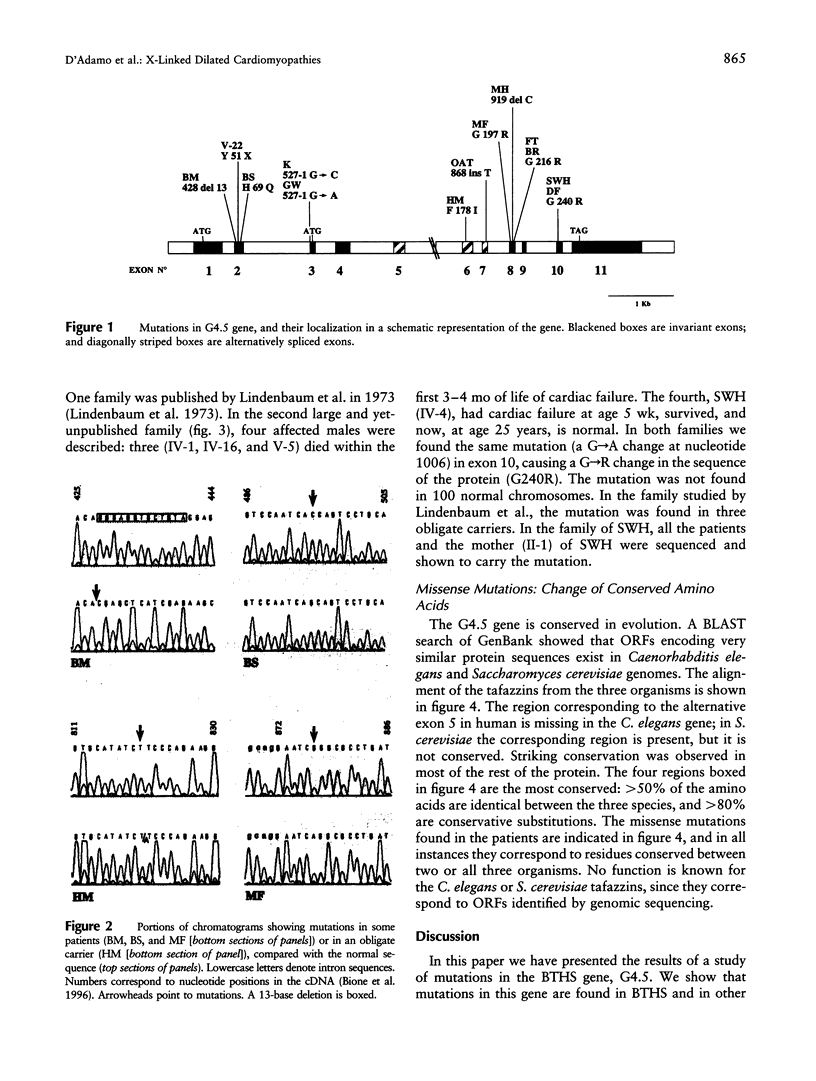
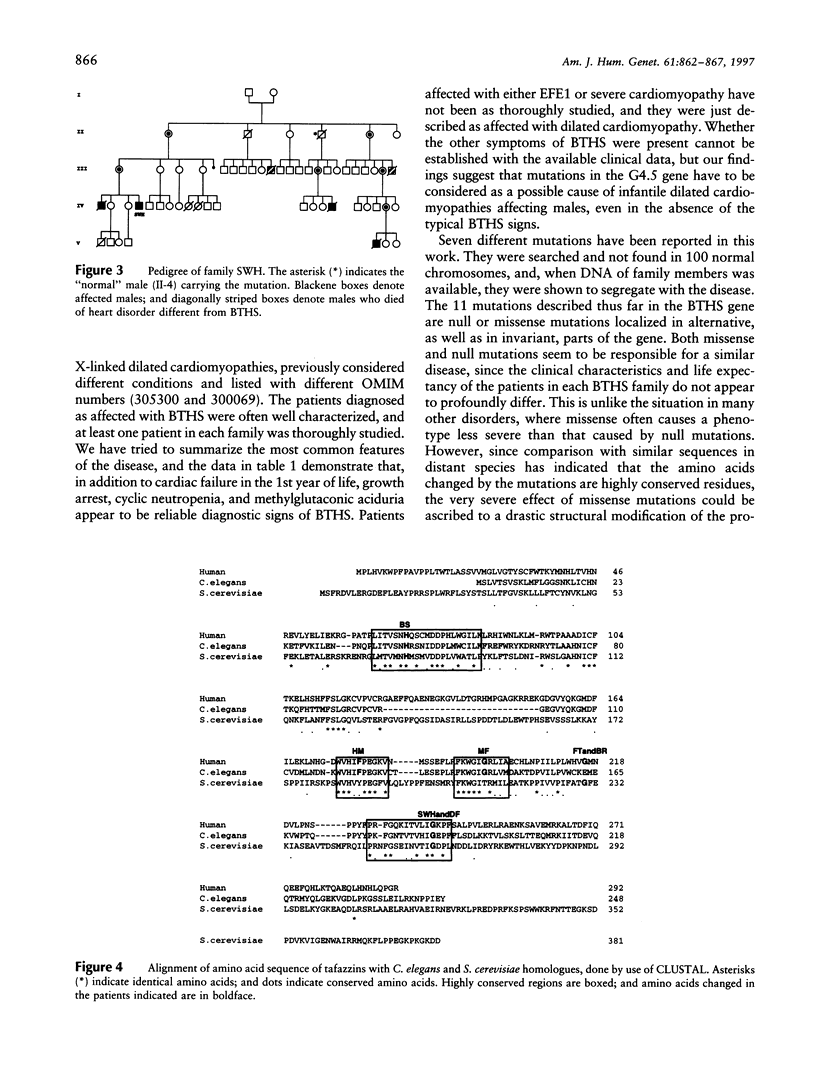
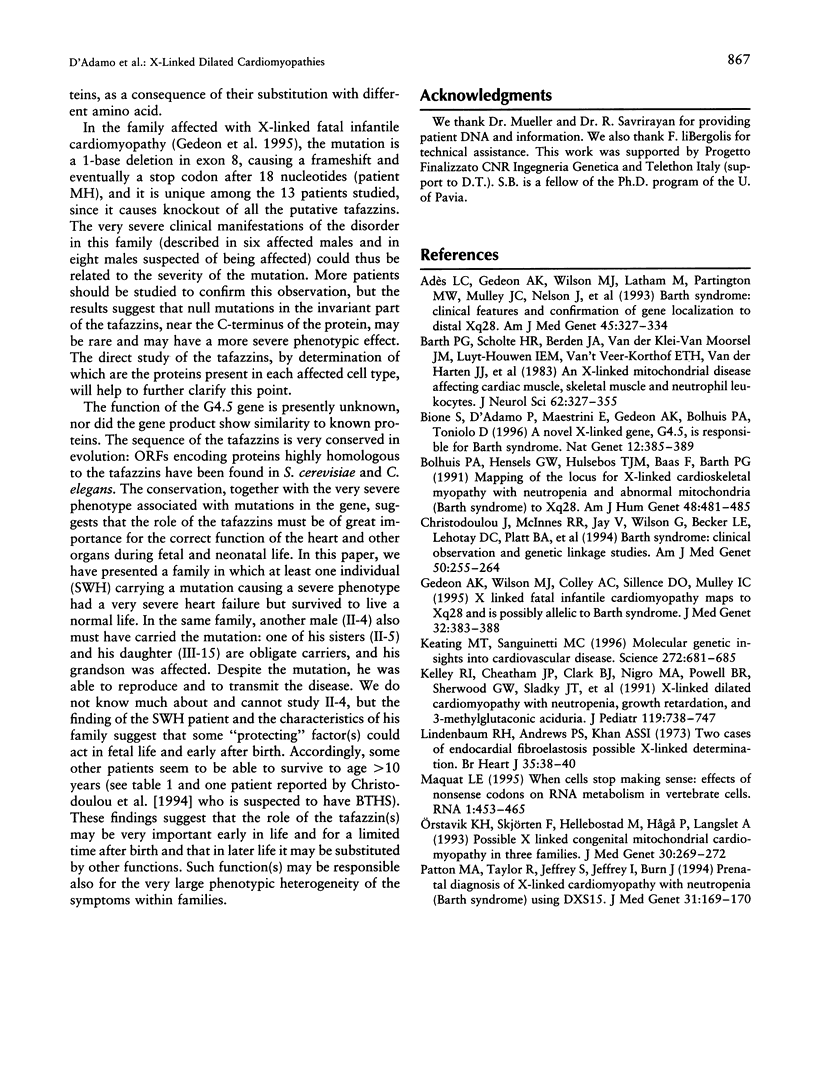
Images in this article
Selected References
These references are in PubMed. This may not be the complete list of references from this article.
- Adès L. C., Gedeon A. K., Wilson M. J., Latham M., Partington M. W., Mulley J. C., Nelson J., Lui K., Sillence D. O. Barth syndrome: clinical features and confirmation of gene localisation to distal Xq28. Am J Med Genet. 1993 Feb 1;45(3):327–334. doi: 10.1002/ajmg.1320450309. [DOI] [PubMed] [Google Scholar]
- Barth P. G., Scholte H. R., Berden J. A., Van der Klei-Van Moorsel J. M., Luyt-Houwen I. E., Van 't Veer-Korthof E. T., Van der Harten J. J., Sobotka-Plojhar M. A. An X-linked mitochondrial disease affecting cardiac muscle, skeletal muscle and neutrophil leucocytes. J Neurol Sci. 1983 Dec;62(1-3):327–355. doi: 10.1016/0022-510x(83)90209-5. [DOI] [PubMed] [Google Scholar]
- Bione S., D'Adamo P., Maestrini E., Gedeon A. K., Bolhuis P. A., Toniolo D. A novel X-linked gene, G4.5. is responsible for Barth syndrome. Nat Genet. 1996 Apr;12(4):385–389. doi: 10.1038/ng0496-385. [DOI] [PubMed] [Google Scholar]
- Bolhuis P. A., Hensels G. W., Hulsebos T. J., Baas F., Barth P. G. Mapping of the locus for X-linked cardioskeletal myopathy with neutropenia and abnormal mitochondria (Barth syndrome) to Xq28. Am J Hum Genet. 1991 Mar;48(3):481–485. [PMC free article] [PubMed] [Google Scholar]
- Christodoulou J., McInnes R. R., Jay V., Wilson G., Becker L. E., Lehotay D. C., Platt B. A., Bridge P. J., Robinson B. H., Clarke J. T. Barth syndrome: clinical observations and genetic linkage studies. Am J Med Genet. 1994 Apr 15;50(3):255–264. doi: 10.1002/ajmg.1320500309. [DOI] [PubMed] [Google Scholar]
- Gedeon A. K., Wilson M. J., Colley A. C., Sillence D. O., Mulley J. C. X linked fatal infantile cardiomyopathy maps to Xq28 and is possibly allelic to Barth syndrome. J Med Genet. 1995 May;32(5):383–388. doi: 10.1136/jmg.32.5.383. [DOI] [PMC free article] [PubMed] [Google Scholar]
- Keating M. T., Sanguinetti M. C. Molecular genetic insights into cardiovascular disease. Science. 1996 May 3;272(5262):681–685. doi: 10.1126/science.272.5262.681. [DOI] [PubMed] [Google Scholar]
- Kelley R. I., Cheatham J. P., Clark B. J., Nigro M. A., Powell B. R., Sherwood G. W., Sladky J. T., Swisher W. P. X-linked dilated cardiomyopathy with neutropenia, growth retardation, and 3-methylglutaconic aciduria. J Pediatr. 1991 Nov;119(5):738–747. doi: 10.1016/s0022-3476(05)80289-6. [DOI] [PubMed] [Google Scholar]
- Lindenbaum R. H., Andrews P. S., Khan A. S. Two cases of endocardial fibroelastosis--possible x-linked determination. Br Heart J. 1973 Jan;35(1):38–40. doi: 10.1136/hrt.35.1.38. [DOI] [PMC free article] [PubMed] [Google Scholar]
- Maquat L. E. When cells stop making sense: effects of nonsense codons on RNA metabolism in vertebrate cells. RNA. 1995 Jul;1(5):453–465. [PMC free article] [PubMed] [Google Scholar]
- Orstavik K. H., Skjörten F., Hellebostad M., Hågå P., Langslet A. Possible X linked congenital mitochondrial cardiomyopathy in three families. J Med Genet. 1993 Apr;30(4):269–272. doi: 10.1136/jmg.30.4.269. [DOI] [PMC free article] [PubMed] [Google Scholar]



